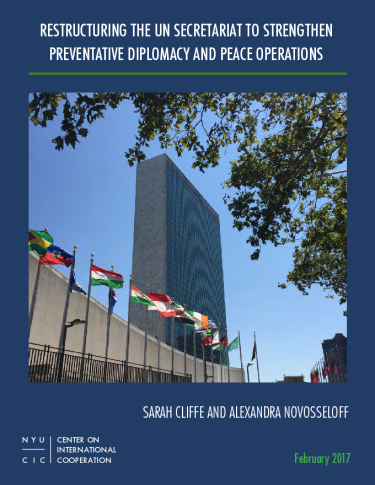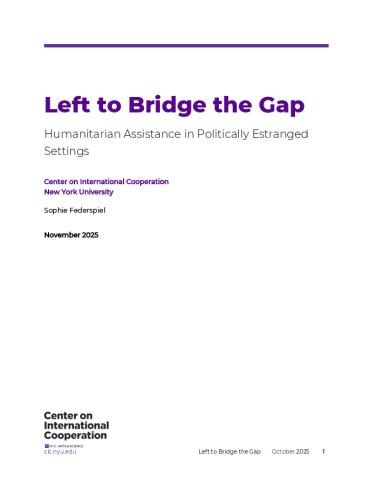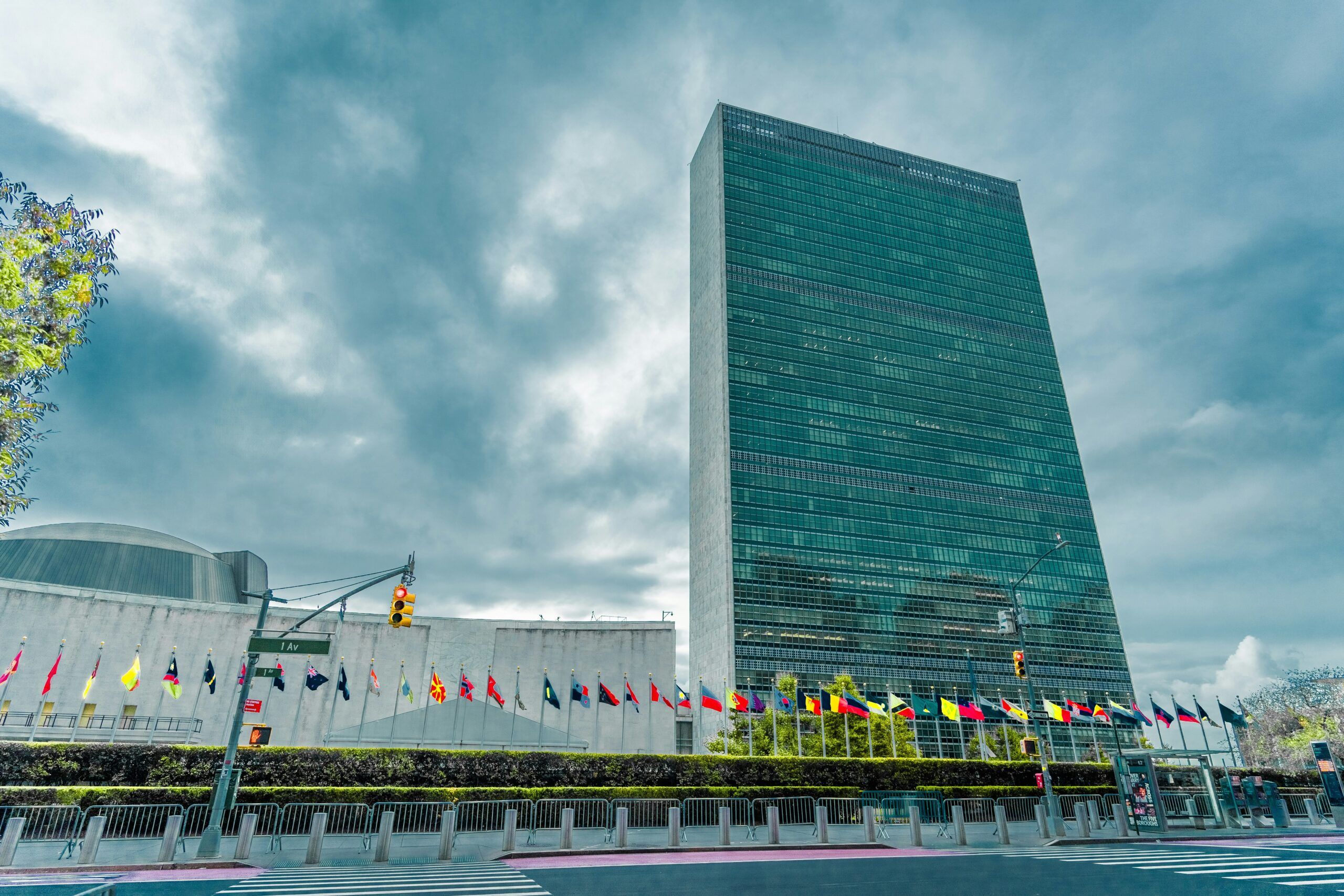Since 1945, the United Nations has helped support many successful peace processes and protected millions of civilians around the world.
Peace operations deliver results: research estimates suggest that the presence of a UN peacekeeping mission can reduce the risk of relapse into conflict by 75 – 85 percent;1 and that larger deployments diminish the scale of violence and protect civilians in the midst of fighting.2 Peace operations can be highly cost effective, with one General Audit Office assessment finding the cost to be roughly half of what a bilateral stabilization operation would cost.3 Different types of peace operations – from mediation and special envoys through to multidimensional peace-keeping and specialized justice and emergency health missions – have helped end long running conflicts and prevented violence from escalating or recurring in situations as diverse as Burkina Faso, Cambodia, the Central African Republic, Gabon, Guatemala, Guinea, Kyrgyzstan, Lebanon, Liberia, Namibia, Sierra Leone and Timor-Leste.
Yet in 2017 the UN’s peace and security pillar faces deep challenges. Three reviews in the past two years have highlighted serious inadequacies in UN peace and security responses at large. Many of the recent challenges are due to real world shifts in the nature of conflict and geopolitical dynamics – the tragedy of Syria, renewed fighting in Yemen and South Sudan, continued crisis in Libya, difficulties in preventing a political and humanitarian crisis in Burundi, longstanding missions that are struggling to deliver sustainable peace in DRC and Haiti, and newer missions in Mali and CAR where geography creates sustained cross-border security risks. These situations are also affected by divisions amongst Member States that have prevented agreement on action in some cases. Part of the weaknesses, however, are managerial and structural. The sense of urgency pervading Member States at the UN, together with a new Secretary-General who has signaled his determination to reform this area, provides the opportunity to take a more fundamental look at what would give the UN’s peace and security pillar the right form to deliver the functions that it is called to serve, now and in the future. The purpose of this report is to analyze options for organizational restructuring in the UN’s peace and security pillar. It focuses on headquarters structures since this has been identified as a primary source of overlap and competition: the purpose however is to deliver better results in the field, from prevention through crisis management to post-conflict recovery. It does not cover wider reforms across the UN’s three pillars, which are supported in other CIC work streams.4
Following an introductory section, Section II traces the history of UN peace and security structures since the UN’s founding (see Box). The UN has had no shortage of reform in the past, each designed to address specific weaknesses or new demands. Cumulatively, however, these changes have resulted in a structure that is no longer fit to fulfill the functions needed.
Section III argues that current problems include:
- Operational challenges of large missions overwhelming a broader “culture of prevention” – despite achieving impressive preventative results in regions such as West Africa, the UN’s resources are often so overstretched in backstopping their larger field operations that there is little space to work on preventing future crises;
- Fragmentation of the system as a whole into silos, which undermine coherent action on prevention, peacebuilding and peacekeeping;
- Lack of a clear political strategy in peace operations that would help societies find sustainable solutions to crises;
- Insufficient authority and resources to galvanize system-wide action on peacebuilding;
- Competition between the departments of political affairs, and peacekeeping, in part due to the fact that both departments have become both political and operational: consequent delays in mission start-up and inability to deliver a spectrum of “right fit” operations and smooth transitions;
- Multiplicity of UN actors and fragmented initiatives for political, security and justice institutional support, although helping build these national institutions is key to preventing conflict onset and recurrence;
- A disconnect between operations and support;
- Inappropriate personnel and fiduciary procedures, and an administrative culture not conducive to dynamic field operations in the context of limited resources.
Section IV starts to look at possible solutions.
From the outset, the report recognizes that changes in the UN’s organigram are not the only – or even necessarily the most important – changes needed. Most fundamentally, without strong leadership and management that ensure departments work together, and Member States support for new approaches, no organizational structure will deliver.Within these limits, Section V considers the options for organizational structures laid out in the box below. A broad range of models is included, for different reasons. Some have been proposed by different reviews, such as a second Deputy Secretary-General and strengthening the political/operational delineation. Some are common currency in the corridors of the UN, such as merging the departments of political affairs and peacekeeping. Some are options indicated by basic principles of organizational design, such as the models that reorganize on a form versus function basis. The report considers the pros and cons of each of these. Section VI underlines the importance of budget, fiduciary and human resource issues and considers options to strengthen this area. In line with much prior work, the report identifies a need for: (i) a unified budget process and rules for all large missions in the field, and; (ii) appropriate fiduciary and human resource procedures, designed for field missions operating in uncertain and insecure environments. Budget design more closely driven by political strategy and including a variety of inputs – a better balance between posts and non-personnel costs – would also be desirable to improve the link with results on the ground. These are longstanding, acknowledged problems: the report tries to present some newer ideas to address them. On the budget side, in addition to grandfathering the scale of assessments for SPMs in a unified account, the report asks whether it would be worth Member States considering a systematic comparison of the UN’s budget spend in similar categories (e.g. operational versus non-operational) across the UN’s three pillars. More factual information may be a way to avoid past debates about whether “too much” is currently given to peace and security, to human rights or to development (see box).On the procedural side, the report asks whether, rather than continuing to make small proposals for improvements to Member States as has been the case in the past decade, it might be desirable for Member States to consider a comprehensive proposal on a set of procedures designed specifically for field operations.
The Purpose of This Report is to Analyze Options for Organizational Restructuring in the UN’s Peace and Security Pillar. The Goal is to Deliver Better Results in the Field, From Prevention Through Crisis Management to Post-Conflict Recovery.
Section VII recommends the following practical considerations for policy makers:
Form should follow function. Which form best fits the organization should be driven by which functions that need to be strengthened. For example, a strong focus on global preventative diplomacy might argue against strengthening geographical departments that could become silos of their own, preventing effective diplomatic outreach to actors in different regions. Equally, if it is important to ensure space for the primacy of politics and preventative diplomacy, this may argue against merging these functions with the day to day running of large field missions.
Span of control matters. Merging a greater number of functions always increases the possibility for synergy. However, it also increases the span of control that any one manager is required to cover – requiring for instance one USG to remain on top of many different functions and a much larger human resource and budget responsibility than his or her peers. This is a primary drawback to the “fusion” models.
The larger the change, the greater the efficiency cost. Changes in responsibilities, reporting lines, accountabilities and physical location all require effort from management and staff, and a necessary time period to settle into new roles. Some of the models described here – for instance the regional model or political-services model – require more change than others. Such a reorganization takes time and consumes a great deal of bureaucratic energy. There are however also opportunity costs in avoiding fundamental change when it is needed, and good change management can mitigate the disruption to activities.
Political feasibility matters. More major changes in relation to current structures or budgets are perhaps more likely to create divisions amongst Member States in the relevant governance committees. In addition, some of models described might bring incidental but important political pressures: concentration of too many sensitive files under a single USG, threatening the position of a USG role that has for some time been held by a powerful Member State or Member State grouping, as in the fusion models, or spurring pressure to appoint USGs from particular regions in the geographical model. If there is doubt about the surrounding Member State dynamics in 2017, following an option where the change is not too significant in relation to current structures may make sense.
Budget and fiduciary issues are linked to the effectiveness of restructuring. Most of the models discussed in this paper (with the exception of the second DSG) would not necessarily require additional resources. But it would be difficult to realize the best results from organizational change unless resources were reallocated to reflect new functions. The politics of gaining consensus on budget issues will also therefore need to be taken into account.
Any restructuring has second round effects. PBSO’s creation was not accompanied by much analysis of the adjustment needed to DPA or DPKO’s activities or the processes followed by country teams; DFS’s creation did not lead to adequate changes in DM’s role to realize the desired result. Not all of these effects can be identified upfront, but it is useful to identify the more major implications and set in place a follow up process to work these through.
These are models with elements that can be combined in practice. This paper looks at the series of models listed above as contrasting organizing ideas. In practice, ideas from more than one may be combined, and the paper gives examples.
Noting that no organigram is perfect, the report does not argue that one option must be better than all others. None of the options presented can work without effective management and governance arrangements. Indeed, whatever way departmental boxes are organized, there will a need for horizontal coordination arrangements and each option will require different coordination permutations. It does however conclude that for several of the models examined, the cons appear to quite significantly outweigh the pros. These include the addition of a second DSG which could increase bureaucratic layers and perpetuate silos; the fusion models which would create significant span of control problems; the regional model which would involve opportunity costs in global preventative functions, high temporary efficiency costs and difficulties in adapting over time; and the option of integrating peace-building under DPA which could face resistance because of the implied loss of a cross-pillar peace-building approach.Conversely the paper argues that the political-operational and political-services model, as well as bringing peace-building closer to EOSG, have more pros than cons and are probably feasible options to consider. These options also appear to fit well with a “form follows function” principle, by reflecting the key functional priorities recently endorsed by Member States. These include the primacy of politics (by strengthening a department focused on political strategy for peace operations and preventative diplomacy) and diminishing silos (by considering ways to draw together departments working on the same area of specialized services to national counterparts).What is eventually proposed might also combine some of these elements. For example, a strong political-operational delineation of functions could be combined with a stronger center of excellence in institutional support services, focused on serving all departments and linked with the UN development system, as well as with strengthening cross-system prevention and peace-building functions in EOSG.
Download the full paper: Restructuring the UN Secretariat to Preventative Diplomacy and Peace Operations
Endnotes
1 See Michael W. Doyle and Nicholas Sambanis, Making War and Building Peace, Princeton University Press, 2006. See also Michael W. Doyle and Nicholas Sambanis, “International Peacebuilding: A Theoretical and Quantitative Analysis” American Political Science Review, Vol. 94, No. 4 2000; Virginia Page Fortna, Does Peacekeeping Work?: Shaping Belligerents’ Choices After Civil War, Princeton University Press, 2008; Michael J. Gilligan and Ernest J. Sergenti “Do UN Interventions Cause Peace? Using Matching to Improve Causal Inference” Quarterly Journal of Political Science, Volume 3, 2008; Virginia Page Fortna “Does Peacekeeping Keep Peace? International Intervention and the Duration of Peace After Civil War “ International Studies Quarterly, Vol. 48, 2004
2 Lisa Hultman, Jacob Kathman, and Megan Shannon “United Nations Peacekeeping and Civilian Protection in Civil War” American Journal of Political Science, Vol. 57, No. 4, 2013 Lisa Hultman, Jacob Kathman, and Megan Shannon “Beyond Keeping Peace: United Nations Effectiveness in the Midst of Fighting” American Political Science Review. Vol. 108, No. 4, 2014
3 GAO, Peacekeeping Cost Comparison of Actual UN and Hypothetical U.S. Operations in Haiti, GAO-06-331, (Washington, D.C.), 21 February 2006.
4 See CIC’s website for further details on these work streams.



